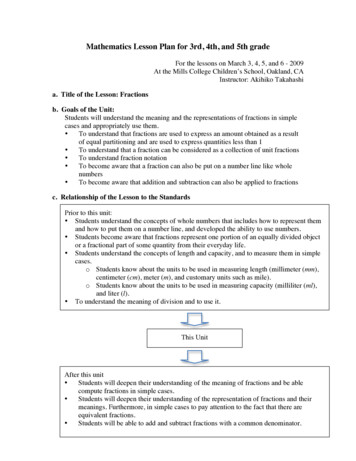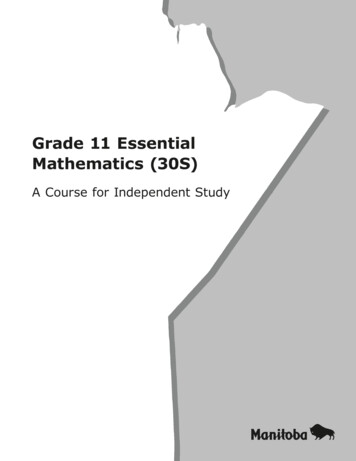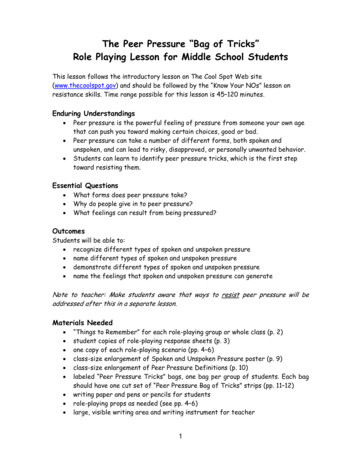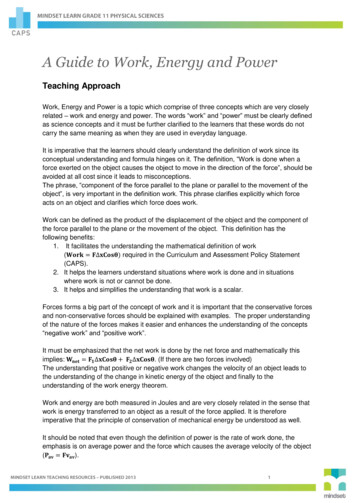
Transcription
Mathematics Lesson Plan for 3rd, 4th, and 5th gradeFor the lessons on March 3, 4, 5, and 6 - 2009At the Mills College Children’s School, Oakland, CAInstructor: Akihiko Takahashia. Title of the Lesson: Fractionsb. Goals of the Unit:Students will understand the meaning and the representations of fractions in simplecases and appropriately use them. To understand that fractions are used to express an amount obtained as a resultof equal partitioning and are used to express quantities less than 1 To understand that a fraction can be considered as a collection of unit fractions To understand fraction notation To become aware that a fraction can also be put on a number line like wholenumbers To become aware that addition and subtraction can also be applied to fractionsc. Relationship of the Lesson to the StandardsPrior to this unit: Students understand the concepts of whole numbers that includes how to represent themand how to put them on a number line, and developed the ability to use numbers. Students become aware that fractions represent one portion of an equally divided objector a fractional part of some quantity from their everyday life. Students understand the concepts of length and capacity, and to measure them in simplecases.o Students know about the units to be used in measuring length (millimeter (mm),centimeter (cm), meter (m), and customary units such as mile).o Students know about the units to be used in measuring capacity (milliliter (ml),and liter (l). To understand the meaning of division and to use it. This UnitAfter this unit Students will deepen their understanding of the meaning of fractions and be ablecompute fractions in simple cases. Students will deepen their understanding of the representation of fractions and theirmeanings. Furthermore, in simple cases to pay attention to the fact that there areequivalent fractions. Students will be able to add and subtract fractions with a common denominator.
d. Unit PlanDay 1Introduction to the unitDay 2How can we expressfractional parts (1)Mathematics forelementary school 3B(Hironaka H. et al., 2006)pp.57-58.How can we expressfractional parts (2)Mathematics forelementary school 3B(Hironaka H. et al., 2006)pp.58-59.The size of fractionMathematics forelementary school 3B(Hironaka H. et al., 2006)pp.60Day 3Day 4 Displaying the datesStudents will deepen their understanding of decimalnotation through solving a problem related to children’severyday life.Students will become aware that fractions can be seen instudents’ everyday life.Students will understand that fractions are used toexpress an amount obtained as a result of equalpartitioning and are used to express quantities less than 1(only unit fractions).Students will understand that a fraction can be consideredas a collection of unit fractions.Students will know fraction notation.Student will become aware that a fraction can be put on anumber line.e. Instruction of the LessonFraction is an important topic in the elementary grades. At the same time, it is one of themost challenging topics for students to understand (U.S. Department of Education, 2008).Although many students have seen fractions in everyday life, e.g. a half mile on thehighway road signs and a quarter pound in a fast-food-chain menu, these students maynot be able to see fractions as numbers and use them comfortably like whole numbers.Researchers argue that the concept of fractions may be well introduced in second gradewith manipulatives but they need to go through a gradual process moving from theconcrete, the semi-concrete, and the abstract in order for them to see fractions as numbers(Gunderson & Gunderson, 1957).According to the Japanese Course of Study Teaching Guide (Takahashi, Watanabe, &Yoshida, 2004), fractions should be introduced to represent one portion of an equallydivided object, or to represent a fractional part of some quantity. After this kind of21introduction, the idea that represents a collection of two units should be taught, as if331is thought of as a unit (Thompson & Saldanha, 2003). Researchers also argue that3students who work with fractions well use words in the beginning rather than the symbol, 2i.e., writing “2 thirds” rather than so that students can see “one third” as a unit just like3measurement unit like miles (Gunderson & Gunderson, 1957). This shows that a fractionis the number that represents some portion of equally divided 1; that is, a fraction has theameaning of 1 b a .b2
It is also important for students to understand that fractions, just like whole numbers anddecimal numbers, are used to represent not only size of numbers and quantities but alsoproportion of numbers and quantities. The Singapore National Curriculum (Ministry ofEducation, 2006) emphasizes that fractions are introduced as part of a wholeinterpretation in the primary 2 and the fraction of a set of objects, which is to representproportion of numbers and quantities, should not be introduced until primary 4. JapaneseCourse of Study also mentions that part of a whole interpretation should be introduced atthe beginning while using fractions to represent proportion of numbers and quantitiesshould not be introduced until grade 5 (Takahashi, Watanabe, & Yoshida, 2008).Based on the above discussion, the present research lesson unit, which consists of fourlessons in four days, is designed for students to deepen their understanding of fractions inorder for them to see that fractions are numbers. This unit is designed based on theEnglish translation of the Japanese mathematics textbook series for the elementarygrades, the most widely used public school mathematics textbook in Japan (Hironaka &Sugiyama, 2006). This series of research lessons support the following key ideas from thetextbook: Fractions are introduced as part of whole interpretation, which is to express anamount obtained as a result of equal partitioning. Fractions are used to express quantities less than 1 in measurement contexts. Diagrams such as tape diagrams and area diagrams are used for students tounderstand that a fraction can be considered as a collection of unit fractions. Tape diagrams and number lines are used for students to see fractions arenumbers just like whole numbers.Since the Japanese textbooks are originally written in Japanese and designed for Japanesechildren who live in Japan, the followings are added to the contents of the Japanesetextbook in order to maximize the benefits of learning for the English speaking childrenwho live in the US. Some examples of fractions from students’ everyday life will be shown in order toencourage students to see that fractions are often used in American society. Students will be given opportunities to write fractions using not only the symbol2but also the word, i.e., writing “2 thirds” in addition to so that students can see3“one third” as a unit. 3
f. Plan of the LessonsDay 1 – March 3, 2009Goal of the lesson: Students will deepen their understanding of decimal notation through solving aproblem related to children’s everyday lifeSteps, Learning ActivitiesTeacher’s Questions and Expected Student Reactions1. IntroductionEncourage students to see the benefit of displaying dateson the wall in each classroom.Rather than writing the date everyday, it might be a goodidea to prepare some cards to display dates so that you canuse all the time.2. Posing the ProblemThink about how many cards we need to display dates onthe wall in your classroom.3. Anticipated Student Responses20 cards13 cards12 cards11 cardsTeacher’s SupportPoints ofEvaluationHelp student awareness that youcan save your effort if youprepare cards to display dates.Help student awareness that youdo not need too many cards todisplay dates.Assemble groups of studentsfrom different grades; maybe one3rd grader, one 4th grader, and one5th grader. Ask older students tohelp younger studentsunderstand.If all the studentsunderstand that wedo not need only31 cards to displaydates because thelargest dates in amonth is 31.Help student awareness that wemight not need 31 cards if weput a digit on each card and usethem for ones and tens.Provide students actual cards ifstudents request.Do students recallwhat they learnedpreviously?Begin discussion with the groupwith the larger number of cards.Encourage students to share withother groups not only how manycards but also what kind of cardsthey want to prepare.Help other groups to understandhow the group came up the ideaand see if the method works forall the dates.Does each studentunderstand otherstudents’ ideas?For the fewest number of thecards, let each student make thecards and try one by one to makesure all the dates of a month canbe displayed with 11 cards. (If astudent does not want to use 6 todisplay 9, he/she can use 12cards).Does each studentunderstand thatonly 11 cards witha digit in each cardare necessary todisplay all thedates of eachmonth?4. Comparing and Discussinga.20 cardsCards for ones: 1, 2, 3, 4, 5, 6, 7, 8, 9, 0Cards for tens: 1, 2, 3, 4, 5, 6, 7, 8, 9, 0b.13 cardsCards for ones: 1, 2, 3, 4, 5, 6, 7, 8, 9, 0Cards for tens: 1, 2, 3c.13 cardsCards for ones: 1, 2, 3, 4, 5, 6, 7, 8, 9, 0Cards for tens: 0, 1, 2d.12 cardsCards for ones: 1, 2, 3, 4, 5, 6, 7, 8, 9, 0Cards for tens: 1, 2e.12 cardsCards for ones: 1, 2, 3, 4, 5, 6, 7, 8, 0Cards for tens: 1, 2, 34
f.4.5.6.11 cardsCards for ones: 1, 2, 3, 4, 5, 6, 7, 8, 0Cards for tens: 1, 2Extending the problemHow many cards do we need to display all the dates ifyou can use both sides of each card?Anticipated Student Responses6 cards Front 1, 2, 3, 4, 5, 6 Back 0, 1, 2, 7, 8, 96 cards Any combination would work if the followingpair of digits are not put on the same cards1 & 1, 2 & 2, 3 & 0Summing up Let each student writes what he/she learnedtoday.Provide students enough cards sothat students can actually try tofind how their ideas work.Help students become awarethere will be multiple correctsolutions to this problem.Does each studentfind a way todisplay all thedates of a month byusing both sides ofsix cards?Encourage students to use theboard writing as an example inorder to summarize what theylearned.Evaluation: Do students see that a digit can be used for not only ones but also tens place, i.e.,3 can be used not only for displaying 23rd but also 31st? Do students recall their understanding of decimal notation? Do students understand the nature of the problem solving approach?5
Day 2 – March 4, 2009Goal of the lesson: Students become aware that fractions can be seen in students’ everyday life. Students will understand that fractions are used to express an amount obtained asa result of equal partitioning and are used to express quantities less than 1 (onlyunit fractions).Steps, Learning ActivitiesTeacher’s Questions and Expected Student Reactions1. IntroductionShowing road signs with fractions to help studentsbecome aware that fractions can be found in everyday life.Ask students what they know about fractions What does each number on the road signrepresent?Students will discuss about what the fractions on the roadsign represent by using their prior knowledge regardingwhole numbers, measurements of distance, and fractions.2. 4.6If some of the students seem notfamiliar with the term fraction,avoid using the term until theclass informally defines the term.Encourage students to help eachother to share their priorknowledge.Points ofEvaluationIs each studentcomfortable usingterm “fraction”?Does each studentsee what thefractions on theroad signrepresent?Posing the ProblemThe length of the tape strip represents the length aroundtrunk of a tree on the campus. The length of the tape stripis a bit longer than 1 m. How can we express the length ofthe fractional part of this tape strip using 1 m tape strip asa reference.3.Teacher’s SupportAnticipated Student Responses About a half meter About a quarter meter The length the fractional part is the same as thelength of a portion that obtained by dividing 1 minto three equal parts. One of the third of 1 m1 3 Some students might want to use their personalreferences such as the length of their hands orbelongings. Some others may want to use yard orfeet.Comparing and Discussing To understand each approach to express thefractional part of the tape strip To understand that a fraction can be used toexpress the length of a fractional part of the tapestripEach student will work with apartner.Each pair of students will use theactual length of the tape strips,1one is 1 m and another is 1 m.3The actual tape strips are similarto the diagrams on the textbookpage.Does eachunderstand that thefractional part canbe expressed byusing 1 m as areference? Encourage students to use 1 m asa reference to create their ownunit in order to express thelength of the fractional part.Through the discussionencourage students to see thatusing a formal unit, such asmeter, as a reference is a goodidea to express quantities.Encourage students to write thelength of the fractional part inthe words, “1 third of 1 meter” or“1 third meter”.Does each studentunderstand that thefractional part canbe expressed usingthird meter as aunit
5. Apply the learning to the similar situationHow to express the following parts of 1 m using thesimilar approach that you learned from the previousproblem? Find the length of a tape strip (1 half meter)Find the length of a tape strip (1 fifth meter)Let’s make 1 quarter-meter tape strip from 1 metertape strip. Ask a couple of younger grade students toexplain how he/she made the tape strip Ask other students to verify if the tape stripsare 1 quarter-meter length.6.Summing up Let each student write what he/she learned today.Provide students actual length oftape strips.Encourage students to work withtheir partners.Once they find the length of eachtape strip, let students writedown the length in the words.Provide 1 meter tape strip foreach student so that each of themcan make own 1 quarter meter.Does each studentunderstand how toexpress the lengthand write it in thewords?Does each studentmake a 1 quartermeter length tapestrip?Encourage students to use theboard writing as an example inorder to summarize what theylearned.Evaluation: Do students understand that an amount obtained as a result of equal partitioningcan be used to express quantities less than 1? Do students understand how to express the length of fractional parts by usingwords such as 1 third?Picture of the road sign7
Day 3 – March 5, 2009Goal of the lesson: Students will understand that a fraction can be considered as a collection of unitfractions. Students will know fraction notation.Steps, Learning ActivitiesTeacher’s Questions and Expected Student Reactions1. IntroductionAsk some students to share what they wrote in theirnotebook the day before.2.Anticipated Student Responses A bit longer than a half meter Twice as long as 1 third meter Two of the third of 1 m2 3 2 thirds meter. 4.Comparing and Discussing To understand that the length of the fractionalpart is twice as long as the 1 third meter tapestrip. To understand that the fractional part can beexpressed as a collection of third. To understand the fractional part can be expressby using the words, 2 thirds meter.5. Apply the learning to another situationHow to express the following parts of 1 liter using thesimilar approach that you learned from the previousproblem? 7.8Points ofEvaluationEach student will work with apartner.Each pair of students will use theactual length of the tape strips,2one is 1 m and another ism.3The actual tape strips are similarto the diagrams in the textbookpage but do not have dots line toshow 1 third. Does eachunderstand that thefractional part canbe expressed byusing 1 m as areference?Posing the ProblemThe length of the tape strip is a bit shorter than 1 m. Howcan we express the length of this tape strip using 1 m tapestrip as a reference.3.Teacher’s SupportFind the amount of the water in the picture(2 fifths liter)Find the amount of the water in the picture(1 fourth liter or 1 quarter liter)Find the amount of the water in the picture(4 sixth liter)Summing up Introduce fraction notation by replacing thewords to express fractional parts.44 sixth liter can be written asliter.6 Encourage students to use thetape strips from the day beforelesson as reference.Encourage students to write thelength of the fractional part inthe words, “2 thirds of 1 meter”or “2 thirds meter”.Does each studentunderstand that thefractional part canbe expressed usingthird meter as aunit?Provide students a picture of theliter cup for each problem.Encourage students to work withtheir partners.Once they find the amount of thewater, let students write downthe amount in the words.Does each studentunderstand how toexpress the amountand write it in thewords?
4are called fractions.66 is called denominator to express the unit,sixth.4 is called numerator to express how many of the unit.Numbers like Let students to use fraction notation to expressthe fractional part that they expressed in thewords during the prior activities.Do the exercises 2 & 3 on the textbook p.59.Let each student write what he/she learned today.Encourage students to use theboard writing as an example inorder to summarize what theylearned.Is each student ableto express thequantities of thefractional parts byusing fractionnotation?Evaluation: Do students understand that a fraction can be considered as a collection of unitfractions? Are students able to write fractions by using fraction notation?9
Day 4 – March 6, 2009Goal of the lesson: Student will aware that a fraction can be put on a number line.Steps, Learning ActivitiesTeacher’s Questions and Expected Student Reactions1. IntroductionAsk some students to share what they wrote in theirnotebook the day before.2. Posing the ProblemBy using the tape strips we have had so far, lets createvarious length of the tape strips.Students can use the following unit fractions to expressvariety of fractions. Half (meter) Third (meter) Quarter/fourth (meter) Fifth (meter) Sixth (liter/meter)3.Anticipated Student Responses 2 halves meter 2 thirds meter, 3 thirds meter 2 fourths meter, 3 fourths meter, 4 fourths meter,2 quarters meter, 3 quarters meter, 4 quartersmeters 2 fifths meters, 3 fifths meters, 4 fifths meters, 5fifths meters 2 sixths meters, 3 sixths meters, 4 sixths meters,5 sixths meters, 6 sixths meters2 2 3 2 3 4 2 3 4 5 2 3 4 5 6 , , , , , , , , , , , , , ,2 3 3 4 4 4 5 5 5 5 6 6 6 6 64.Comparing and Discussing Through sharing the fractions, students will haveopportunities to express, interpret, validate thefractions in the word and the fraction notation. Organize fractions according to the size of theunit fraction, put the fractions with the samedenominator on the same number line. Compare the size of fractions with the samedenominators.Summing up Do the exercise in the textbook p.60. Let each student write what he/she learned today. 8.Teacher’s SupportPoints ofEvaluationEach student will work with apartner.Each pair of students will use thetape strips from the previousdays as a unit fraction in order tomake several different lengths oftape strip.Each group will have a cashregister paper role to make tapestrips.Does eachunderstand that thefractional part canbe expressed byusing 1 m as areference?Encourage students to write thelength of the fractional part inthe words, “2 thirds of 1 meter”or “2 thirds meter” and by thefraction notation.Does each studentunderstand that thefractional part canbe expressed bothin the words andfraction notation?Encourage students to use theboard writing as an example inorder to summarize what theylearned.Evaluation: Are students able to put fractions on number lines?10
References:Gunderson, A., & Gunderson, E. (1957). Fraction Concepts Held by Young Children.Arithmetic Teacher, 4 (October 1957), 168 - 173.Hironaka, H., & Sugiyama, Y. (Eds.). (2006). Mathematics for Elementary School.Tokyo, Japan: Tokyo Shoseki Co., Ltd.Ministry of Education, S. (2006). Mathematics Syllabus Primary.Takahashi, A., Watanabe, T., & Yoshida, M. (2004). Elementary School Teaching Guidefor the Japanese Course of Study: Arithmetic (Grade 1-6). Madison, NJ: , GlobalEducation Resources.Takahashi, A., Watanabe, T., & Yoshida, M. (2008). English Translation of the JapaneseMathematics Curricula in the Course of Study, March, 2008,Grades 1-9. Madison, NJ: Global Education Resources.Thompson, P. W., & Saldanha, L. i. A. (2003). Fractions and Multiplicative Reasoning.In J. Kilpatrick, W. G. Martin & D. Schifter (Eds.), A Research Companion toPrinciples and Standards for School Mathematics (pp. 95-111): National Councilof Teachers of Mathematics.U.S. Department of Education (2008). Foundations for Success: The Final Report of theNational Mathematics Advisory Panel. Washington, DC.11
Mathematics Lesson Plan for 3rd, 4th, and 5th grade For the lessons on March 3, 4, 5, and 6 - 2009 At the Mills College Children’s School, Oakland, CA Instructor: Akihiko Takahashi a. Title of the Lesson: Fractions b. Goals of the Unit: Students will understand t










